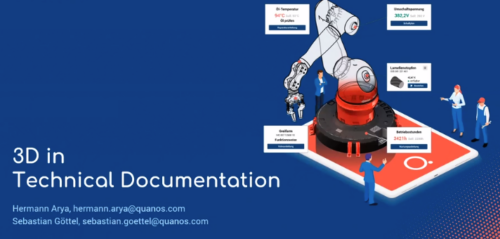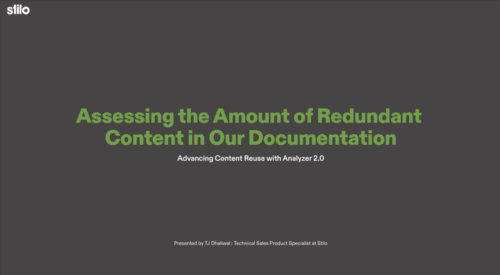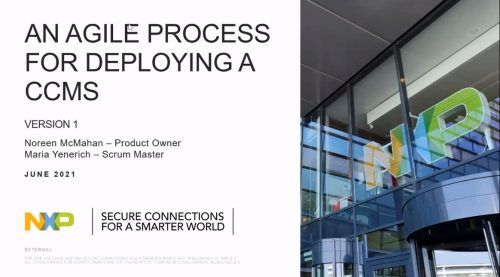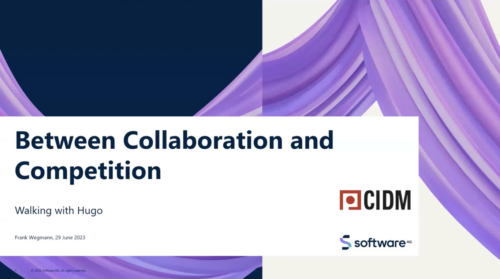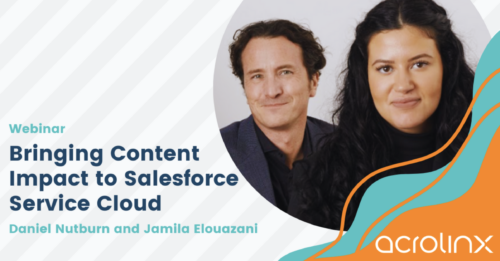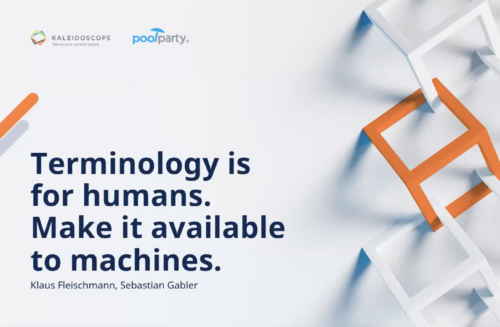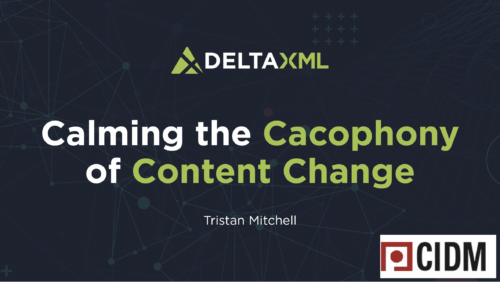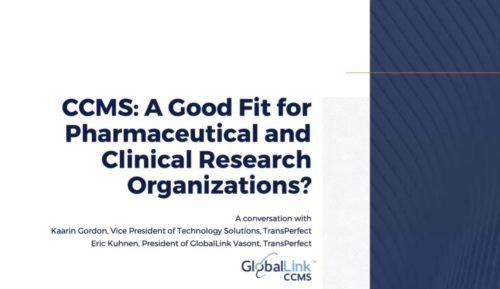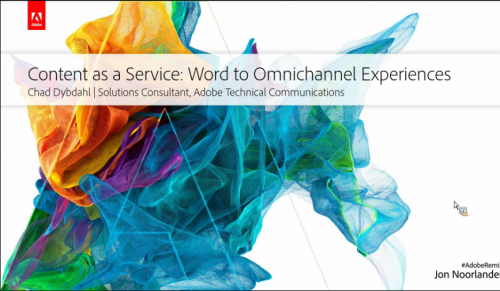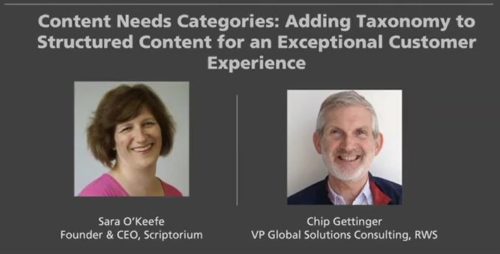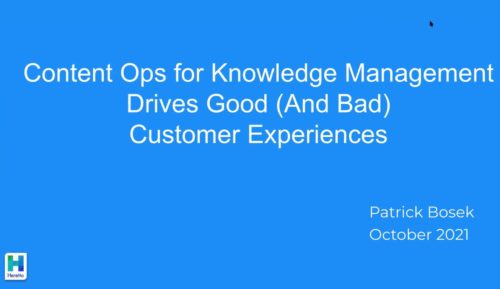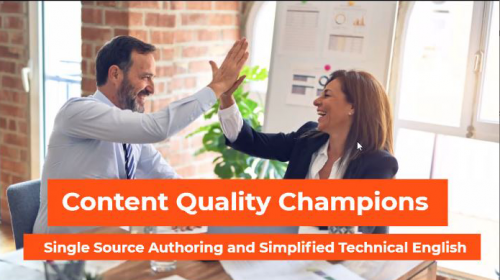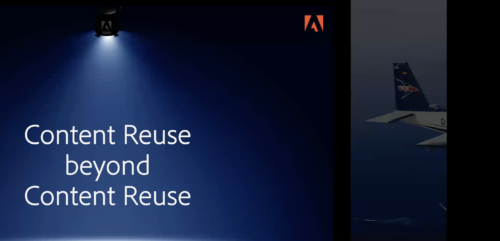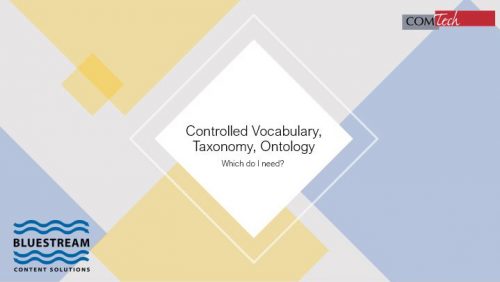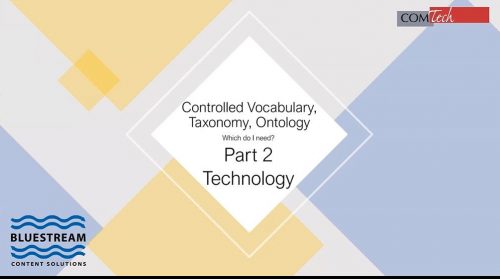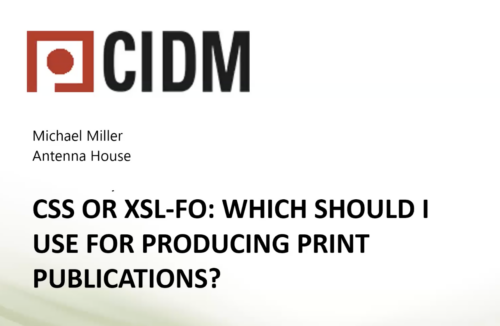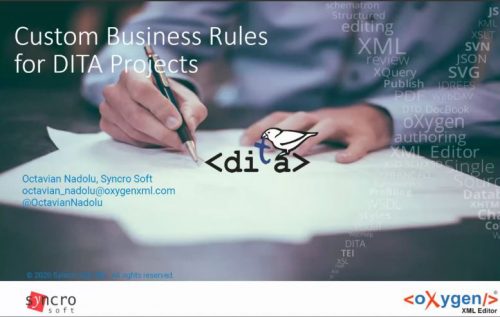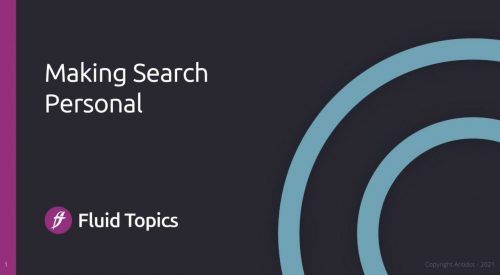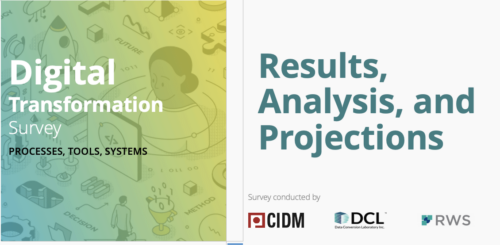-
Recorded on September 15, 2022

3D has become indispensable in engineering departments. But 3D models rarely find their way into technical documentation. In spare parts catalogs, 3D catalogs have become standard thanks to automatic processing. There, people appreciate that 3D views are intuitively understandable and offer additional interactivity in online documentation. What can technical authors learn from the 3D experiences of the spare parts catalog world?
What steps are necessary in a CCMS to not only visually enhance online documentation with interactive 3D data, but also to enable new access to information? Which formats and tools can be used?
Presented by:
Sebastian Göttel is Head of Marketing and Product Management at Quanos Content Solutions GmbH. The computer scientist has been involved with XML editing systems and content delivery since 1998. In the Tekom environment, he worked on version 1.0 of the iiRDS standard. [email protected]
Hermann Arya is a digital professional with 15+ years of experience in the aftersales project environment. In Europe he was and still is responsible for the revolution and evolution of 3D visualizations in the service information system context. As Head of Professional Service at Quanos Service Solutions GmbH and through the execution of well over 150 customer projects, he has also been able to build up extensive knowledge of the value chain around service information systems. [email protected]
-
Recorded on April 26, 2023

One significant benefit of adopting a structured standard like DITA is content reuse, which can reduce redundancy, improve consistency, and minimize overall content. However, due to typos, partial matches, and other inconsistencies, estimating the value of content reuse can be challenging- especially before the conversion occurs. By using Analyzer, users can narrow down their approximation and investigate similar matches in their source content before the conversion, providing valuable insight into the potential benefits of adopting a structured standard. Capture valuable metrics to substantiate content projects to key stakeholders. Learn how businesses can manage their content more effectively, increase productivity, and better understand content reuse's value in their documentation.
Join TJ as he uses Stilo’s Analyzer to investigate source content for hidden reuse. The latest release from Stilo offers a range of improvements to the user management system, product architecture, and sequence GUI redesign to streamline your content management process.
Presented by TJ Dhaliwal, Stilo
TJ Dhaliwal is a Technical Sales Product Specialist at Stilo, helping customers uncover solutions to their content conversion needs. With a solid technical background in engineering and a passion for public speaking, he’s successfully bridged the gaps between project stakeholders. As a problem solver, TJ has helped several enterprise-level companies convert tens of thousands of pages of their content to DITA.
-
June 30, 2021 NXP successfully deployed a DITA CCMS in 2016, in a SaaS environment, to manage technical product documentation. A software and system upgrade to Tridion Docs 14 (CCMS) was planned in 2019-20 to take advantage of new capabilities, performance improvements, system and infrastructure updates. Managing a successful CCMS upgrade requires detailed coordination, planning, testing, communication, and execution. From the webinar, you will learn how NXP effectively utilizes SAFe methodologies, together with their CCMS vendor RWS, to manage and execute the upgrade. Noreen and Maria worked together to coordinate activities on an NXP Agile Release Train (ART) as both are SAFe-certified. Noreen heads the RWS core team, which consists of representatives from several NXP business lines. Maria is from IT, working as the upgrade project Scrum Master. Overall, the upgrade was a success, as it was completed on time and within budget. NXP did encounter some unexpected issues that were managed following this process. During this webinar, Noreen and Maria will discuss how the business and IT benefited by utilizing SAFe methodologies to document CCMS configurations, develop and execute test cases for upgrade testing, managed communications with RWS and third-party vendors, communicated benefits to the business users, and moved all users into an upgraded production system with minimal interruptions. Presented by: Maria Yenerich works as a Scrum Master within the NXP Marketing Information Technology (IT) group. With 20+ years of system management experience, Maria has an undergraduate degree from Creighton University and a Master’s of Business Administration from the University of Illinois. Noreen McMahan has a Ph.D. from the University of Texas in Austin. In 2008, Noreen joined a team deploying a new CCMS in a global company. For almost a decade, she trained users of the CCMS around the world. She authored the online training in the DITA environment using the same tools as the writers and engineers she trained. She began her role as NXP RWS Product Owner after working on a team that deployed SDL LiveContent Architect as the new NXP CCMS in 2016. Later, as the 2020 pandemic gained momentum, Noreen worked on an Agile team that successfully completed an RWS upgrade of the CCMS to Tridion 14. She, therefore, has experience in deploying a new CCMS and in upgrading an existing one. Chip Gettinger is VP Global Solutions Consulting at RWS, managing a team that works with customers in maximizing global content with RWS. He has experience working with customers to develop global content strategies, business ROI adoption drivers, change management, and technology adoption for component content management systems. He speaks and blogs about customer successes working closely with industry standards, partners, and customers in technology solutions and deployments.
-
Recorded on June 29, 2023
 In recent years the software industry has seen a rising trend towards lightweight documentation on the side of SMEs. While this may work on a small scale, it may get tricky when there is a need to interact with more corporate documentation environments. Bridging the gap between markup and markdown can present challenges not only on the technical level. So-called static site generators (SSG) are often used to bring Markdown content to the audience, focusing on speed, layout and ease of use, but they lack productivity features that are baked into DITA right away and essential to technical documentation. Enter a scenario in which you need to pull markup-agnostic content contributors to the other side and learn how Lightweight DITA might help you to foster collaboration instead of deepening competition. Let us see how far a walk with Hugo, a very popular SSG, can take us in this scenario and discuss the implications of a fragmenting corporate documentation landscape.
In recent years the software industry has seen a rising trend towards lightweight documentation on the side of SMEs. While this may work on a small scale, it may get tricky when there is a need to interact with more corporate documentation environments. Bridging the gap between markup and markdown can present challenges not only on the technical level. So-called static site generators (SSG) are often used to bring Markdown content to the audience, focusing on speed, layout and ease of use, but they lack productivity features that are baked into DITA right away and essential to technical documentation. Enter a scenario in which you need to pull markup-agnostic content contributors to the other side and learn how Lightweight DITA might help you to foster collaboration instead of deepening competition. Let us see how far a walk with Hugo, a very popular SSG, can take us in this scenario and discuss the implications of a fragmenting corporate documentation landscape.
Presented by Frank Wegmann
Frank Wegmann has 20+ years of experience in the markup world. Rooted in multilingual university research projects using SGML and XML, he has been advancing custom automated build systems for technical documentation at Software AG since 2001. In recent years the original focus shifted to DITA, and, inevitably, also Markdown. He is a regular speaker at international conferences and engaged in OASIS DITA committees, where he now also acts as co-chair of the Lightweight DITA subcommittee.
-
September 29, 2021 Not all Analytics are created equal. Nor are they fit for the same purpose. Google Analytics and other web analytics tools are incredibly helpful for marketing content. But when it comes to product documentation, they are outranged by dedicated Content Analytics. Next-gen Content Analytics is designed for technical content and understand the complexity and structure of your documentation down to the topic level. Far beyond the web analytics capabilities, they generate the type of insights that benefit not only the tech content professionals but the entire organization. In this webinar, you will learn how the documentation team can capture meaningful content metrics and drive change and improvement to the content, the product, and ultimately to customer service and user satisfaction leveraging dedicated Content Analytics. Presented by: Fabrice Lacroix is a serial entrepreneur and a technology pioneer. He has been working for 25 years on the development of innovative solutions around search technology, content enrichment and AI. He is the founder of Fluid Topics, the leading Content Delivery Platform that reinvents how users search, read and interact with technical documentation.
-
January 17, 2024 9:00 am – 10:30 am PT | 12:00 pm – 1:30 pm ET | 5:00 pm – 6:30 pm GMT

Far too often, GenAI projects are considered the exclusive realm of IT, while Knowledge and Content Development teams remain in the background. Unfortunately, this approach often leads these projects to failure.
Presented by Fabrice Lacroix, Lief Erickson, and Amber Swope
Join us for an insightful webinar exploring why content developers and information architects must be at the forefront of GenAI Projects. Discover how their expertise and insights propel AI initiatives, transforming content into dynamic, user-centric solutions. Learn why empowering content specialists with GenAI projects is critical for fostering innovation and enhancing customer experiences.
This webinar is presented by Amber Swope DITA specialist at DITA Strategies, Lief Erickson, Principal Consultant at Intuitive Stack, and Fabrice Lacroix, CEO and founder of Fluid Topics.
Fabrice Lacroix is a serial entrepreneur and a technology pioneer. He has been working for 25 years on the development of innovative solutions around search technology, content enrichment and AI. He is the founder of Fluid Topics, the leading Content Delivery Platform that reinvents how users search, read and interact with technical documentation.
 Lief Erickson is co-founder of Intuitive Stack, a content strategy consultancy. He holds a master’s degree in Content Strategy from FH Joanneum (Austria), where he teaches information architecture. ContentOps, taxonomies, and search are leading interests for Lief, who has held positions as a tech writer and IA.
Lief Erickson is co-founder of Intuitive Stack, a content strategy consultancy. He holds a master’s degree in Content Strategy from FH Joanneum (Austria), where he teaches information architecture. ContentOps, taxonomies, and search are leading interests for Lief, who has held positions as a tech writer and IA.
 Amber Swope is an internationally recognized Information Architect, DITA expert, and IA consultant. With over 20 years of information development experience and 15 years of DITA expertise, Amber specializes in helping organizations create opportunity through IA.
Amber Swope is an internationally recognized Information Architect, DITA expert, and IA consultant. With over 20 years of information development experience and 15 years of DITA expertise, Amber specializes in helping organizations create opportunity through IA. -
Recorded on June 14, 2023

Delivering Value to Customers Is More Imperative Than Ever.
Join Acrolinx VP of Global Partner and Alliances, Dan Nutburn and Director of Partner Solutions, Jamila Elouazani for this webinar as they discuss:- How Salesforce Service Cloud users can improve the quality and consistency of their content
- Real-world examples of how and why customers are using the newly updated Salesforce Knowledge + Acrolinx Integration
- Why the AppExchange program is so important to Salesforce and its customers
This webinar will also feature special guest Julia Taube, ISV Manager at Salesforce.
Presented by Daniel Nutburn and Jamila Elouazani Daniel Nutburn is an accomplished executive and the Vice President of Global Partners and Alliances at Acrolinx. Daniel's got a wealth of experience in channel development, alliance management, and software solution selling. He's built an international partner network and has a solid track record of success with blue-chip and high-growth software companies.
Beyond his professional achievements, Dan is most proud of his ability to embarrass his daughters with his Karaoke singing and Cacti collection. LinkedIn: https://www.linkedin.com/in/daniel-nutburn/
Daniel Nutburn is an accomplished executive and the Vice President of Global Partners and Alliances at Acrolinx. Daniel's got a wealth of experience in channel development, alliance management, and software solution selling. He's built an international partner network and has a solid track record of success with blue-chip and high-growth software companies.
Beyond his professional achievements, Dan is most proud of his ability to embarrass his daughters with his Karaoke singing and Cacti collection. LinkedIn: https://www.linkedin.com/in/daniel-nutburn/
 Jamila Elouazani is the Director of Partner Solutions, Global at Acrolinx, a leading content optimization technology for enterprise companies. With years of experience working in solution and product-focused environments, Jamila has honed her skills in providing technical support to businesses looking to close deals with Fortune 500 companies.
Jamila Elouazani is the Director of Partner Solutions, Global at Acrolinx, a leading content optimization technology for enterprise companies. With years of experience working in solution and product-focused environments, Jamila has honed her skills in providing technical support to businesses looking to close deals with Fortune 500 companies.In addition to her professional accomplishments, Jamila is a family-oriented individual who enjoys expressing her creativity through singing and fashion design. Her passion for both the arts and technology has allowed her to bring a unique perspective to her work in the content optimization industry.
With her strong technical background and creative mindset, Jamila has become a respected thought leader in the industry and is committed to helping businesses achieve their content optimization goals.
-
Recorded on June 21, 2023
 Taxonomies and terminologies can be seen as different sides of the same coin. However, the focus is quite different. Taxonomies make linguistic data available for machines and humans to distill knowledge and often to manage chaos. Terminologies harmonize language, make sure everyone uses consistent and correct words, and try to avoid chaos from the outset. Organizations obviously require both, so it is only natural for Semantic Web Company and Kaleidoscope to integrate their two platforms and offer a combined taxonomy and terminology management solution.
Taxonomies and terminologies can be seen as different sides of the same coin. However, the focus is quite different. Taxonomies make linguistic data available for machines and humans to distill knowledge and often to manage chaos. Terminologies harmonize language, make sure everyone uses consistent and correct words, and try to avoid chaos from the outset. Organizations obviously require both, so it is only natural for Semantic Web Company and Kaleidoscope to integrate their two platforms and offer a combined taxonomy and terminology management solution.
This presentation and demo show you:
- how to connect your Pool Party taxonomy to the Kalcium terminology suite
- and add terminology benefits to your existing data:
- human-grade, rich metadata, organizational decision workflows, and automatic guidance in word choice for authors and translators alike
Presented by Klaus Fleischmann and Sebastian Gabler

Klaus Fleischmann studied translation and IT in Vienna, and holds an MA in Conference Interpreting from Monterey, California, and a MAS in Technical Communication from Krems, Austria. In 1996, he founded Austria-based Kaleidoscope, a company implementing content, translation, and terminology management processes for internationally active companies. Kaleidoscope develops online collaboration software for enterprise-level terminology workflow, translator query management, in-country review, etc., making the translation quality process comprehensible and strategically manageable. In 2007, he became CEO of Austria´s leading LSP, Eurocom Translation Services. Always active in the industry, Klaus got voted into the Gala Board of Directors in 2015 and 2017.
 Sebastian Gabler originally trained as a Recording Producer with a diploma from the Berlin University of the Arts (UdK) and 5 years of music production for radio, TV, and the recording industry; he has been pursuing a career in archive and information management for over 15 years
Sebastian Gabler originally trained as a Recording Producer with a diploma from the Berlin University of the Arts (UdK) and 5 years of music production for radio, TV, and the recording industry; he has been pursuing a career in archive and information management for over 15 yearsIn 2017, he joined Semantic Web Company in Vienna and was appointed Chief Customer Officer in 2020. In this position, he supports customers from all industries in developing intelligent applications with semantic AI. Sebastian has worked in various companies in the areas of technology, sales, and project management, including 11 years in the field of audiovisual archiving, and has recently completed his Master of Sciences in Library and Information Science.
-
Recorded on October 5, 2023

If there’s one thing that never changes, it’s that everything changes. And when it comes to technical documentation, keeping on top of change can become overwhelming. Whether you’re releasing on the same schedule as the software you’re documenting, or working to your own time frame, deadlines add extra pressure. How can you be sure that you have control over the changes that are being made? How do you know that unintended changes aren’t slipping through the net? How can you satisfy regulators and keep them updated with requested changes?
In this webinar, we’ll share our top tips for managing changing content and calming the cacophony it can create.
Presented by: Tristan Mitchell, DeltaXML Tristan is Product Director at DeltaXML, a technology company with world-leading software products for the management of change in structured content. He has a deep understanding of DeltaXML’s product suite and loves to help customers create extra value in their content using change management. Tristan is a father to three daughters, a movie lover, and a keen runner.
Tristan is Product Director at DeltaXML, a technology company with world-leading software products for the management of change in structured content. He has a deep understanding of DeltaXML’s product suite and loves to help customers create extra value in their content using change management. Tristan is a father to three daughters, a movie lover, and a keen runner.
-
December 8, 2021 Kaarin Gordon discusses the choices and challenges for efficient content reuse facing Pharmaceutical and Clinical Research Organizations. What they want is a set of tools and platforms for easy content reuse, automatic propagation of changes from a single source, and content governance. What they have is Microsoft Word; it’s easy to use but limited to cut-n-paste content reuse. What they must deliver is multi-lingual content for a variety of uses – faster, more cost-effectively, and at lower risk. Join Eric Kuhnen in conversation with Kaarin Gordon for an engaging discussion of how component content management systems amplify or ameliorate some of the difficult content complexities that organizations face today. Presented by: As the Vice President of Life Sciences Technology Solutions at TransPerfect, Kaarin Gordon works closely with organizations on solutions to more effectively develop, manage, translate, and deliver multilingual content. She has spent 20+ years working with pharma, CROs, and medical device companies and focused on developing and implementing solutions that address global content challenges and result in decreased cycle time, reduced risk, increased consistency, and lower costs. Kaarin has a BA from the University of Michigan and an MBA from Columbia University. Eric Kuhnen is the President of GlobalLink Vasont, one of TransPerfect’s GlobalLink CCMS solutions. He has more than 30 years of experience in product research, development, and management. Prior to his current role, managed global operations, product management, pre-sales, and marketing for Astoria Software, a division of TransPerfect, Inc. He has also held profit-loss responsibilities with GoRemote and Oracle Corporation. He has a Bachelor of Science degree in Computer Science from Brigham Young University.
-
Date: August 12, 2020 Squatches, yeti, and kraken: oh, my! Learn about cryptozoology, cryptids, and… oh yes: the future of content strategy and digital experiences. Chad Dybdahl, Adobe Solutions Consultant, walks you through importing content from Microsoft Word, creating intelligent, structured content that can then be used across a wide range of delivery channels and platforms. In this session, we’ll see both traditional and headless delivery strategies that will inspire you to think about content in new and exciting ways.
- Strategies to repurpose your technical content in new ways
- Headless content delivery: what is it and why you need it
- Creating structure from (MS Word) chaos
-
June 2, 2021 Various surveys are showing that the majority of the world’s leading companies have accelerated their digital transformation efforts during the pandemic – efforts that are not slowing down. This presentation will discuss the key role content plays in the field of digitalization, and what you should do to future proof your content while elevating your customer experience. Presented by: Berry Braster has been in the technical documentation field for over 18 years and has helped implement content strategies, including the use of DITA and HyperSTE controlled language software. As Technology Director, Berry is involved with connecting technical documentation to IoT, and how to leverage on technologies like Augmented and Virtual Reality.
-
Recorded: February 23, 2022 Structured content provides numerous benefits for organizations with authoring, managing, and delivering information. Perhaps your organization has realized these benefits—but what’s next? A formal content classification system, or a taxonomy, provides a framework that supports search, filtering, classification, consistent terminology, and more. The combination of taxonomy and structured content opens up compelling possibilities for digital delivery. Add continuous updates and advancements in business data, and you can transform the customer experience—but you may feel a little exposed out on the leading edge of technology. Sarah and Chip will present and discuss emerging trends, techniques, and technology for your digital information initiatives. During the webinar you’ll learn:
- How do you select and manage a good taxonomy?
- Classifying content – human, machine, or a combination?
- Coordinating taxonomy terms across various teams and languages
- Taking advantage of Semantic AI
- Business drivers examining tagging quality vs. quantity
- Best practices and actions for you
-
October 6, 2021 Our content shapes experiences and drives behavior. The question then becomes, is your content causing positive or negative experiences and behaviors? In this presentation, we’ll take a critical look at content operations (Content Ops), the processes behind your knowledge, and how they make or break customer experiences. You’ll learn:
- Tactics to turn your haphazard workflow into a repeatable process
- Overlooked signs that your content hinders customer experience
- How to ensure your content capability can scale with your company’s growth
-
March 31, 2021 How do you ensure that your content is consistent and follows your brand’s guidelines? How do you begin a project that’s consistent across your technical communications? Is it an achievable goal? What results should I expect? In this webinar, learn how the combination of easyDITA's CCMS and HyperSTE allows you to check your content against your specific style guide, as well as industry standard grammar and terminology rules. The result is not only scalable and single-sourced content, but clear and concise content across the board. Content that's more cost effective, brand aligned, and ready to attract new customers. Attendees will learn:
- The value of combining an XML CCMS with a Grammarly-like content checker
- A live demo of easyDITA with HyperSTE that shows how the tools work together to help content creators
- A general project plan to help you get started in achieving great results
- An example of a customer implementation and their results
-
Recorded on November 30, 2022
 Content reuse has been a topic for content managers for years. And the benefits and practices are now established in many organizations. For the most part, however, content reuse is still limited to the classic, “internal” reuse of an information unit across documentation. Time to say: Let‘s rethink content reuse – beyond internal reuse, to reuse in new channels.
In this presentation, Stefan Gentz, Senior Worldwide Evangelist at Adobe, will discuss why we need to rethink technical content and share some ideas on increasing the value of information both within the organization and for the customer. He will share some use cases that go beyond traditional PDF and web publishing and repurpose technical content to create immersive, interactive experiences.
Presented by Stefan Gentz
Content reuse has been a topic for content managers for years. And the benefits and practices are now established in many organizations. For the most part, however, content reuse is still limited to the classic, “internal” reuse of an information unit across documentation. Time to say: Let‘s rethink content reuse – beyond internal reuse, to reuse in new channels.
In this presentation, Stefan Gentz, Senior Worldwide Evangelist at Adobe, will discuss why we need to rethink technical content and share some ideas on increasing the value of information both within the organization and for the customer. He will share some use cases that go beyond traditional PDF and web publishing and repurpose technical content to create immersive, interactive experiences.
Presented by Stefan Gentz
 Stefan Gentz is the Senior Worldwide Evangelist for Technical Communication at Adobe, headquartered in San Jose, California, USA. Stefan’s mission is to inspire enterprises and technical writers around the world and show how to create compelling technical communication content with the Adobe Technical Communication tools. He is also a certified Quality Management Professional (TÜV), ISO 9001 / EN 15038 auditor, ISO 31000 Risk Management expert, and Six Sigma Champion.
As a sought-after keynote speaker and moderator at conferences around the world, he travels around the globe half of the year. Besides that, he has been the European Ambassador for the Globalization and Localization Association (GALA) for many years, a member of the tekom Conference Advisory Board for several years, and a founding member of the tekom iiRDS working group for Intelligent Information and member of the OASIS DITA Adoption Committee.
In 2016, Stefan Gentz was awarded by MindTouch as one of the Top 25 Leading Content Strategist Influencers in the world and as one of the Top 25 Content Experience Influencers in the world in 2017. Stefan is also the mastermind behind Adobe DITAWORLD, the world’s biggest DITA Online Conference for Marketing and Technical Communication Professionals.
Stefan Gentz on LinkedIn
https://www.adobe.com/products/one-adobe-solution-for-technical-content.html
Stefan Gentz is the Senior Worldwide Evangelist for Technical Communication at Adobe, headquartered in San Jose, California, USA. Stefan’s mission is to inspire enterprises and technical writers around the world and show how to create compelling technical communication content with the Adobe Technical Communication tools. He is also a certified Quality Management Professional (TÜV), ISO 9001 / EN 15038 auditor, ISO 31000 Risk Management expert, and Six Sigma Champion.
As a sought-after keynote speaker and moderator at conferences around the world, he travels around the globe half of the year. Besides that, he has been the European Ambassador for the Globalization and Localization Association (GALA) for many years, a member of the tekom Conference Advisory Board for several years, and a founding member of the tekom iiRDS working group for Intelligent Information and member of the OASIS DITA Adoption Committee.
In 2016, Stefan Gentz was awarded by MindTouch as one of the Top 25 Leading Content Strategist Influencers in the world and as one of the Top 25 Content Experience Influencers in the world in 2017. Stefan is also the mastermind behind Adobe DITAWORLD, the world’s biggest DITA Online Conference for Marketing and Technical Communication Professionals.
Stefan Gentz on LinkedIn
https://www.adobe.com/products/one-adobe-solution-for-technical-content.html
-
March 9, 2021 Ironically, the terms utilized to describe a vocabulary of words used to organize and catalog information within a content corpus often are used inconsistently or interchangeably. However, each term represents a point, on an increasing scale of complexity and resulting data richness and applicability. In this two-part webinar, Dawn Stevens of Comtech Services defines key points along this scale, comparing and contrasting the scope and domain to which each term applies, suggesting when each might be used, and recommending the processes for creating it. Dawn is joined by Rik Page of Bluestream, who will demonstrate real-life examples of each in use. Participants will gain clarity about the approach required to make content more accessible for their users. View part 2 of this webinar here. Presented by: Dawn Stevens is the President, and owner of Comtech Services and the Director of the Center for Information-Development Management. With over 25 years of experience, including 20 years at Comtech, Dawn has practical experience in virtually every role within a documentation and training department, including project management, instructional design, writing, editing, and multimedia programming. With both engineering and technical communication degrees, Dawn combines a solid technical foundation with strong writing and design skills to identify and remove the challenges her clients face in producing usable, technical information and training. Rik Page is Sales and Marketing Director at Bluestream Software and has been working with both component content and document management solutions since 2001. During this time, he has worked with custom DTDs and Schemas, S1000D, iSpec2200 and since 2005 DITA. His practical experience ranges from data capture/content creation through to dynamic multichannel delivery, achieved in a wide range of industries including banking and finance, manufacturing, central government and education. A keen advocate of technology and innovation Rik has taken part in multiple consultancy projects and helped formulate solutions all over the world. Away from the office Rik is a Scout Leader working with young people and helping them to develop new skills whilst having fun.
-
April 6, 2021 Ironically, the terms used to describe a vocabulary of words that organize and catalog information within a content corpus are often used inconsistently or interchangeably. However, each term represents a point on an increasing scale of complexity and resulting data richness and applicability. Following Part 1 of this webinar in which Dawn Stevens of Comtech Services defined and compared these points along the taxonomy spectrum (view part 1 recording), Rik Page of Bluestream now demonstrates the technology and tools that enable you to define and manage your terms and relationships, as well as those that consume what you have defined. Participants will see practical, real-life applications of the taxonomical concepts previously presented. Click here to download the reading list referenced during this webinar. Presented by: Dawn Stevens is the President, and owner of Comtech Services and the Director of the Center for Information-Development Management. With over 25 years of experience, including 20 years at Comtech, Dawn has practical experience in virtually every role within a documentation and training department, including project management, instructional design, writing, editing, and multimedia programming. With both engineering and technical communication degrees, Dawn combines a solid technical foundation with strong writing and design skills to identify and remove the challenges her clients face in producing usable, technical information and training. Rik Page is Sales and Marketing Director at Bluestream Software and has been working with both component content and document management solutions since 2001. During this time, he has worked with custom DTDs and Schemas, S1000D, iSpec2200 and since 2005 DITA. His practical experience ranges from data capture/content creation through to dynamic multichannel delivery, achieved in a wide range of industries including banking and finance, manufacturing, central government and education. A keen advocate of technology and innovation Rik has taken part in multiple consultancy projects and helped formulate solutions all over the world. Away from the office Rik is a Scout Leader working with young people and helping them to develop new skills whilst having fun.
-
August 10, 2020 Content developers and managers worldwide are coming together to share ideas and inspire each other at ConVEx in September. When first announced, we said ConVEx is not an online simulation of an in-person conference, but an immersive experience designed from the ground up to use our e-resources in the best possible way to bring you a wealth of ideas and information to support your efforts in defining and executing a comprehensive content strategy. During this Webinar, Dawn Stevens explains what we mean by this statement and what you can expect and gain from this new event format. We'll discuss the event format, the technology we'll use, and highlight the many networking activities provided. By the end of the Webinar, you'll know why you should attend ConVEx — it's an opportunity to have a positive experience, converge with others in the industry, focus your attention on industry issues, and magnify your value to your organization. Presented by: Dawn Stevens, President, Comtech Services and Director of CIDM has 28 years of practical experience in virtually every role within a documentation and training department, including project management, instructional design, writing, editing, and multimedia programming. Dawn is the perfect advisor to identify and remove the challenges you face in producing usable, technical information and training content. With both engineering and technical communication degrees, Dawn combines her solid technical foundation with strong writing and design skills to lead our team of consultants and specialists in providing the expertise you need.
-
Recorded on June 8, 2023

In this webinar, you will learn about the two recognized international standards available to address the fully automated formatting of pages and publications for PDF and print: CSS and XSL-FO. We will explore the two standards and address:
- When you should use automated document formatting versus desktop publishing
- The motivations for and benefits of automated document formatting
- The challenges
- Where CSS and XSL-FO fit within solutions for the overall delivery of formatted pages and publications

Michael Miller is Vice President of Antenna House, Inc., a company that has developed one of the leading standards‐based (XSL‐FO and CSS) document formatting software products on the market today. Michael has a degree in Printing Engineering and Management and has been involved in high‐end composition, document formatting, and document management for over 40 years. He has an extensive background with structured data, including SGML, XML, S1000D, and DITA. During his career, he has worked in Europe and North America and has been involved in the implementations of some of the largest fully automated publishing and document formatting projects.
-
December 16, 2020 A step by step guide to getting started with Schematron and Schematron Quick Fixes. Schematron and Schematron QuickFix (SQF) languages can be used to improve efficiency and quality when editing DITA documents. You can define actions that will add complex structure in your documents, or make modifications in multiple places or actions that will convert a structure into another. These changes are made by keeping the document structure valid and conforming to your project specification and will help the content writer add content more easily and without making mistakes. Join us to see:
- How to create business rules with Schematron
- How Schematron rules are applied
- How to apply specific Schematron rules on all DITA files
- How to develop Schematron Quick Fixes to make it very easy to solve the reported problems
-
Recorded on: February 8, 2024
 Presented by: André Schlotz, RWS; Hareesh K, Sandvik Mining and Construction GmbH; and Harald Stadlbauer, MD, NINEFEBLearn how Sandvik Mining and Construction makes their DITA-based technical content fit to support their global servitization strategy. For many years Sandvik is creating, managing, translating, and publishing conditionalized DITA content with RWS technology and services. This content has been created with a “Safety First” approach and published as PDFs. Sandvik`s new digital service offerings – enabled through connected products - require customers and service technicians to retrieve personalized and relevant information components through their Web-based aftersales application My Sandvik / SmartMate with the new paradigm: provide the right information, for the right use case at the right time. To enable this a semantic data layer has been implemented combining existing taxonomies, product-structures and iiRDS. DITA topics are now tagged by taking advantage of the Semantic AI capabilities – so called “Smart Tagging”. The hereby created smart content components are then delivered and exposed in a content-as-a-service approach.
Presented by: André Schlotz, RWS; Hareesh K, Sandvik Mining and Construction GmbH; and Harald Stadlbauer, MD, NINEFEBLearn how Sandvik Mining and Construction makes their DITA-based technical content fit to support their global servitization strategy. For many years Sandvik is creating, managing, translating, and publishing conditionalized DITA content with RWS technology and services. This content has been created with a “Safety First” approach and published as PDFs. Sandvik`s new digital service offerings – enabled through connected products - require customers and service technicians to retrieve personalized and relevant information components through their Web-based aftersales application My Sandvik / SmartMate with the new paradigm: provide the right information, for the right use case at the right time. To enable this a semantic data layer has been implemented combining existing taxonomies, product-structures and iiRDS. DITA topics are now tagged by taking advantage of the Semantic AI capabilities – so called “Smart Tagging”. The hereby created smart content components are then delivered and exposed in a content-as-a-service approach.
André Schlotz is VP Global Automotive and Manufacturing Solutions, RWS Group. He helps organizations to digitalize their content supply chain through structured content authoring, component content management and single source content delivery. Before joining RWS in 2013 he was holding various management positions in manufacturing companies in product development, aftersales, process organization and IT. He has more than 20 years of experiences in process consulting, planning, building and running digital industry solutions.
 Hareesh Kanakaswamy is the Portfolio Manager of Digital Services Solutions at Sandvik Mining and Construction G.m.b.H. With 14+ years of experience in product development and aftermarket operations, he specializes in constructing end-to-end digital ecosystems for servitization strategies. Hareesh is a firm believer in innovation as the key to sustainable progress for humanity.
Hareesh Kanakaswamy is the Portfolio Manager of Digital Services Solutions at Sandvik Mining and Construction G.m.b.H. With 14+ years of experience in product development and aftermarket operations, he specializes in constructing end-to-end digital ecosystems for servitization strategies. Hareesh is a firm believer in innovation as the key to sustainable progress for humanity.
 Harald Stadlbauer, MD is General Manager of the NINEFEB Group of companies, dedicated to the advancement of Technical Communication, like Technical Documentation as well as eLearning to the intelligent delivery of it. He is actively engaged in developing iiRDS further as well as contributing to the AAS (Asset Administration Shell) sub-models of the IDTA (Industrial Digital Twin Association)
Harald Stadlbauer, MD is General Manager of the NINEFEB Group of companies, dedicated to the advancement of Technical Communication, like Technical Documentation as well as eLearning to the intelligent delivery of it. He is actively engaged in developing iiRDS further as well as contributing to the AAS (Asset Administration Shell) sub-models of the IDTA (Industrial Digital Twin Association)
-
May 26, 2021 What if the search function on your tech doc was providing personalized results and was as good as Google, reading the mind of your users and anticipating their needs? What about a search engine that learns and gets more accurate, more relevant and personal every day. What does it take to get there? It’s mostly about technology, but not only. It also requires information: about your content (metadata) and about your users (profiles). In this Webinar, we will introduce the challenges, review the possible solutions, and discuss what you need to have and do in order to support this shift to a modern user experience. Presented by: Fabrice Lacroix is a serial entrepreneur and a technology pioneer. He has been working for 25 years on the development of innovative solutions around search technology, content enrichment and AI. He is the founder of Fluid Topics, the leading Content Delivery Platform that reinvents how users search, read and interact with technical documentation.
-
Recorded: August 25, 2022


 Digital Transformation is often defined as the process of using digital technologies to create or optimize business processes to improve company and customer experience and meet changing customer demand and market requirements.
Digital transformation may involve spending thousands, hundreds of thousands, or even millions of dollars purchasing new tools and technologies. No matter how many new tools and systems and how much money you put toward transforming your organization, a large piece of the digital transformation puzzle comprises a content transformation.
CIDM, DCL, and RWS wanted to understand what steps people are taking toward “digital transformation” and where content structure and information architecture fit into the plan. The three organizations launched a three-month long “Digital Transformation Survey” to understand how various industries address the adoption of processes, technology, tools, and information architecture.
The results have been collected, analyzed, and discussed. Now it’s time to share the results and our observations with you. No matter what industry you work in, digital transformation is happening on many levels, and understanding how your peers are applying resources, budget, and strategies can contribute to your success.
Presented by:
Digital Transformation is often defined as the process of using digital technologies to create or optimize business processes to improve company and customer experience and meet changing customer demand and market requirements.
Digital transformation may involve spending thousands, hundreds of thousands, or even millions of dollars purchasing new tools and technologies. No matter how many new tools and systems and how much money you put toward transforming your organization, a large piece of the digital transformation puzzle comprises a content transformation.
CIDM, DCL, and RWS wanted to understand what steps people are taking toward “digital transformation” and where content structure and information architecture fit into the plan. The three organizations launched a three-month long “Digital Transformation Survey” to understand how various industries address the adoption of processes, technology, tools, and information architecture.
The results have been collected, analyzed, and discussed. Now it’s time to share the results and our observations with you. No matter what industry you work in, digital transformation is happening on many levels, and understanding how your peers are applying resources, budget, and strategies can contribute to your success.
Presented by:
 Dawn Stevens, President, Comtech Services and Director of CIDM has 28 years of practical experience in virtually every role within a documentation and training department, including project management, instructional design, writing, editing, and multimedia programming. Dawn is the perfect advisor to identify and remove the challenges you face in producing usable, technical information and training content. With both engineering and technical communication degrees, Dawn combines her solid technical foundation with strong writing and design skills to lead our team of consultants and specialists in providing the expertise you need.
Dawn Stevens, President, Comtech Services and Director of CIDM has 28 years of practical experience in virtually every role within a documentation and training department, including project management, instructional design, writing, editing, and multimedia programming. Dawn is the perfect advisor to identify and remove the challenges you face in producing usable, technical information and training content. With both engineering and technical communication degrees, Dawn combines her solid technical foundation with strong writing and design skills to lead our team of consultants and specialists in providing the expertise you need.
 Mark Gross, President, Data Conversion Laboratory, is a recognized authority on XML implementation and document conversion. Mark also serves as Project Executive, with overall responsibility for resource management and planning. Prior to joining DCL in 1981, Mark was with the consulting practice of Arthur Young & Co. Mark has a BS in Engineering from Columbia University and an MBA from New York University. He has also taught at the New York University Graduate School of Business, the New School, and Pace University. He is a frequent speaker on the topic of automated conversions to XML and SGML.
Mark Gross, President, Data Conversion Laboratory, is a recognized authority on XML implementation and document conversion. Mark also serves as Project Executive, with overall responsibility for resource management and planning. Prior to joining DCL in 1981, Mark was with the consulting practice of Arthur Young & Co. Mark has a BS in Engineering from Columbia University and an MBA from New York University. He has also taught at the New York University Graduate School of Business, the New School, and Pace University. He is a frequent speaker on the topic of automated conversions to XML and SGML.
 Chip Gettinger is the VP of Global Solutions Consulting at RWS, he manages a team that works with customers in maximizing global content with RWS. He has experience working with customers to develop global content strategies, business ROI adoption drivers, change management, and technology adoption for component content management systems. He speaks and blogs about customer successes working closely with industry standards, partners, and customers in technology solutions and deployments.
Chip Gettinger is the VP of Global Solutions Consulting at RWS, he manages a team that works with customers in maximizing global content with RWS. He has experience working with customers to develop global content strategies, business ROI adoption drivers, change management, and technology adoption for component content management systems. He speaks and blogs about customer successes working closely with industry standards, partners, and customers in technology solutions and deployments.

